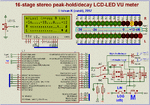zuisti
Advanced Member level 1

Compiler: mikroC Pro for PIC v6.01
Proteus-only projects, using 2x16 LEDs and/or a 4x20 LCD
I made four projects that are in different folders:
16F88_LED............18-pin PIC, 2x16 leds, exact timed multiplexing
44K22_LED............40-pin PIC, non-multiplexed (direct) led control
16F684_LCD..........14-pin PIC, 4x20 LCD
44K22_LCD-LED.....LCD and LEDs, both at a time (see the video)
Common features:
- runtime switchable characteristic:
. lin: 6 to 100 %
. log: -36 to +12 dB, 3 dB/step
- a real wav audio file is used as an input (cannot be heard in Proteus)
- adjustable input LEVEL (sensitivity)
- 250 Hz refresh rate (4 ms)
LED bargraph:
- level-dependend LED colours (12 green, 3 yellow, 1 red; a total of 16 leds)
LCD:
- 16 chars wide bargraph using User Defined Chars (UDCs)
- always visible scale-line (part of all UDCs)
- displayed audio channel (R and L) and current unit (% or dB)
- displayed scale values (second line)
- level-dependend shapes (UDCs) to imitate the different led colours
- runtime switchable 3 different sets of shapes (UDCs): three diff. modes
- the first line shows the current characteristic (lin-log) and mode (0-1-2)
For more description see the included "README_FIRST.TXT" (and the source) files.
--------------
A video to show how to works the simulated LED and LCD VU meter
(the "44K22_LCD-LED" project was used, its circuit is attached as a GIF):

© Istvan K (zuisti), 2017
Proteus-only projects, using 2x16 LEDs and/or a 4x20 LCD
I made four projects that are in different folders:
16F88_LED............18-pin PIC, 2x16 leds, exact timed multiplexing
44K22_LED............40-pin PIC, non-multiplexed (direct) led control
16F684_LCD..........14-pin PIC, 4x20 LCD
44K22_LCD-LED.....LCD and LEDs, both at a time (see the video)
Common features:
- runtime switchable characteristic:
. lin: 6 to 100 %
. log: -36 to +12 dB, 3 dB/step
- a real wav audio file is used as an input (cannot be heard in Proteus)
- adjustable input LEVEL (sensitivity)
- 250 Hz refresh rate (4 ms)
LED bargraph:
- level-dependend LED colours (12 green, 3 yellow, 1 red; a total of 16 leds)
LCD:
- 16 chars wide bargraph using User Defined Chars (UDCs)
- always visible scale-line (part of all UDCs)
- displayed audio channel (R and L) and current unit (% or dB)
- displayed scale values (second line)
- level-dependend shapes (UDCs) to imitate the different led colours
- runtime switchable 3 different sets of shapes (UDCs): three diff. modes
- the first line shows the current characteristic (lin-log) and mode (0-1-2)
For more description see the included "README_FIRST.TXT" (and the source) files.
--------------
A video to show how to works the simulated LED and LCD VU meter
(the "44K22_LCD-LED" project was used, its circuit is attached as a GIF):

© Istvan K (zuisti), 2017


